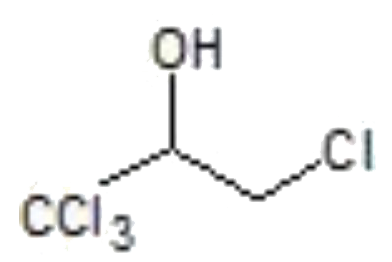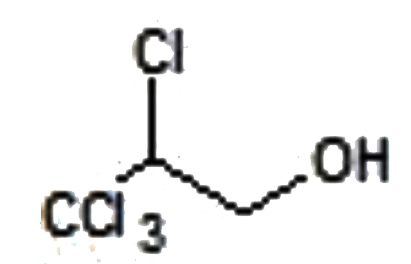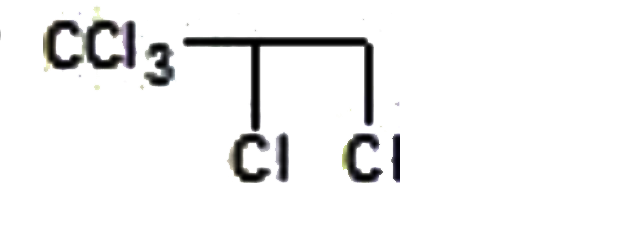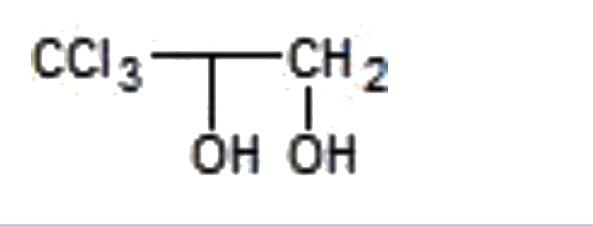CCl3CH=CH2Cl2+H2O−−−−−→A, is




The correct Answer is:B
To solve the problem, we need to analyze the reaction of the compound CCl3CH=CH2 with Cl2 in the presence of water. Let's break it down step by step.
Step 1: Identify the Reactants
The reactant is CCl3CH=CH2, which is an alkene with a double bond between the second and third carbons. The presence of Cl2 and H2O indicates that we will be performing an electrophilic addition reaction.
Hint: Look for the functional groups and the type of reaction taking place (electrophilic addition).
Step 2: Understand the Reaction Mechanism
In the presence of Cl2 and H2O, the Cl2 will dissociate to form Cl+ (electrophile) and Cl−. The water will generate hypochlorous acid HOCl, which can also participate in the reaction.
Hint: Recognize that alkenes react with electrophiles due to their nucleophilic nature.
Step 3: Electrophilic Attack
The Cl+ will attack the double bond of the alkene. The double bond can attack the electrophile at either carbon, leading to the formation of two possible carbocations:
1. If Cl+ adds to the first carbon (C1), we get a secondary carbocation.
2. If Cl+ adds to the second carbon (C2), we get a primary carbocation.
Hint: Consider the stability of the carbocations formed during the reaction.
Step 4: Determine the More Stable Carbocation
The secondary carbocation (formed by adding Cl+ to C1) is more stable than the primary carbocation (formed by adding Cl+ to C2) due to hyperconjugation and inductive effects from the CCl3 group.
Hint: Stability of carbocations is key in determining the major product.
Step 5: Nucleophilic Attack by Water
Once the more stable carbocation is formed, water (H2O) will act as a nucleophile and attack the carbocation. This will lead to the formation of a product where one of the chlorine atoms is replaced by a hydroxyl group (OH).
Hint: Look for the final product structure after the nucleophilic attack.
Step 6: Final Product Formation
The final product will be CCl3CH(OH)CH2Cl. This product has a hydroxyl group and a chlorine atom attached to the carbon chain.
Hint: Check the structure of the final product against the given options to identify the correct answer.
Conclusion
After analyzing the reaction, the major product A formed from the reaction of CCl3CH=CH2 with Cl2 and H2O is CCl3CH(OH)CH2Cl.
The reactant is CCl3CH=CH2, which is an alkene with a double bond between the second and third carbons. The presence of Cl2 and H2O indicates that we will be performing an electrophilic addition reaction.
In the presence of Cl2 and H2O, the Cl2 will dissociate to form Cl+ (electrophile) and Cl−. The water will generate hypochlorous acid HOCl, which can also participate in the reaction.
The Cl+ will attack the double bond of the alkene. The double bond can attack the electrophile at either carbon, leading to the formation of two possible carbocations:
2. If Cl+ adds to the second carbon (C2), we get a primary carbocation.
The secondary carbocation (formed by adding Cl+ to C1) is more stable than the primary carbocation (formed by adding Cl+ to C2) due to hyperconjugation and inductive effects from the CCl3 group.
Once the more stable carbocation is formed, water (H2O) will act as a nucleophile and attack the carbocation. This will lead to the formation of a product where one of the chlorine atoms is replaced by a hydroxyl group (OH).
The final product will be CCl3CH(OH)CH2Cl. This product has a hydroxyl group and a chlorine atom attached to the carbon chain.
After analyzing the reaction, the major product A formed from the reaction of CCl3CH=CH2 with Cl2 and H2O is CCl3CH(OH)CH2Cl.
Topper's Solved these Questions
Similar Questions
Knowledge Check
CCl3CH=CH2Cl2H2O−−−−→A. A is :
AHCCl3C∣OH=CH2ClBHCCl3C∣OH=CH2OHCHCCl3C∣Cl−C∣ClH2DHCCl3C∣OH−C∣OHH2CCl3CH=CH2Cl2+H2O−−−−−→A. उपरोक्त अभिक्रिया में A है
A B
B C
C D
D
Cl3CCH=CH2Cl2+H2O−−−−−→A, A is
ACl3CC∣OHHCH2ClBCl3CC∣ClHCH2OHCCl3CC∣ClhC∣ClH2DCl3CC∣HOhC∣OHH2
In the following reaction :
H3C−CH3| C | CH3−CH=CH2H2O/H⊕−−−−−→A
The major product A is :
View SolutionCH3−CH=CH2Cl2/H2O−−−−−→
The correct product is
View SolutionThe major product of the following addition reaction is : H3C−CH=CH2Cl2/H2O−−−−−→
View SolutionCCl3−CH=CH2HOCl−−−→P (Major product ),
CCl3−CH=CH2HOCl−−−→'P' is :
View SolutionIn the following sequence of reactions, the alkene affords the compound 'B'
CH3CH=CHCH3O3−−→AH2O−−→ZnB, The compound B is :
View Solution
